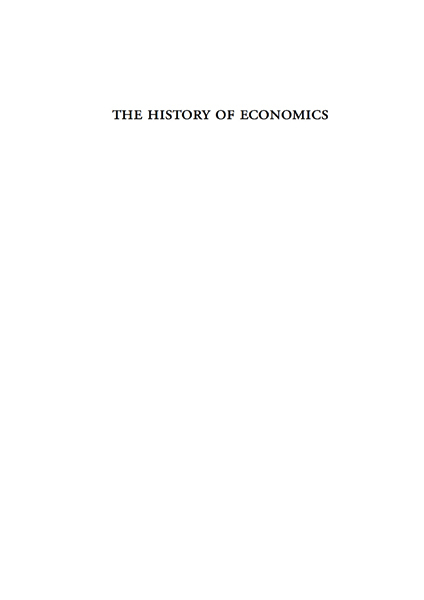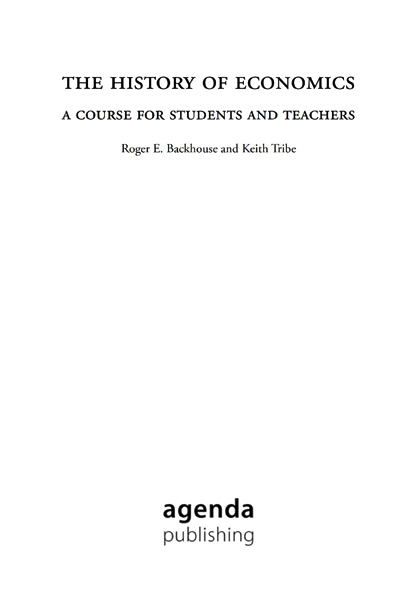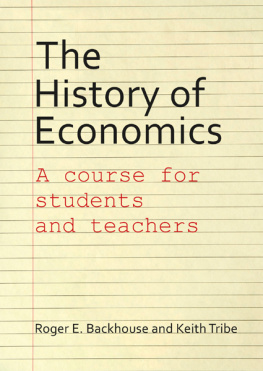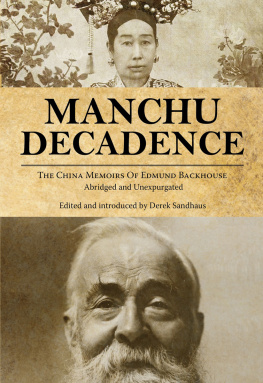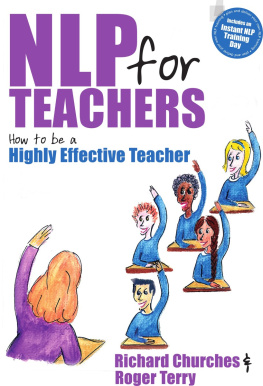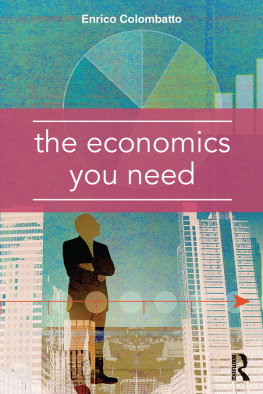Roger E. Backhouse and Keith Tribe 2018
This book is copyright under the Berne Convention.
No reproduction without permission.
All rights reserved.
First published in 2018 by Agenda Publishing
Agenda Publishing Limited
The Core
Science Central
Bath Lane
Newcastle upon Tyne
NE4 5TF
www.agendapub.com
ISBN 978-1-911116-69-1 (hardcover)
ISBN 978-1-911116-70-7 (paperback)
British Library Cataloguing-in-Publication Data
A catalogue record for this book is available from the British Library
Typeset by T&T Productions Ltd, London
Printed and bound in the UK by TJ International
Contents
Introduction
There is today a resurgence of interest in the history of economics, but students often lack the opportunity of taking a systematic course that introduces them to the ideas, policies and writers who played a part in the development of economic thinking from the seventeenth century up to the present day. This book offers a partial solution to this problem by providing a template for students and teachers seeking orientation in the subject. It is based on the material that we have taught to third-year undergraduates at the University of Birmingham for several years, augmented with some material that one of us has covered with graduate students at the University of Oporto and at Erasmus University Rotterdam, expanding it a little beyond our 20 two-hour lectures. We have structured it in such a way that shorter courses could be based on a selection, and we make some suggestions regarding this below.
That this is not a conventional textbook will be apparent from the formal presentation of each lecture, beginning with aims, then providing an annotated bibliography and the relevant chronology before moving on to the subject matter of the lecture. Each lecture ends with a series of questions for discussion that could provide a framework for class discussion or individual reflection. In scope and presentation, then, there is a clear difference here from Roger Backhouses Penguin History of Economic Thought (published in North America by Princeton University Press as The Ordinary Business of Life ), the textbook we recommend our students to read for initial orientation and which covers the history of economic thought from the ancient Greeks onwards. Likewise, chapter 2 of Keith Tribes Economy of the Word provides an extended overview of the transformation in the use of the word economy from the Greeks to the 1960s that provides a more discursive initial orientation.
From the 1920s onwards economic argument rapidly became more formalized and academic, so that what had hitherto largely been public economic debate increasingly becomes debate between academic economists. Before the 1920s economic thinking was both more diverse and less institutionally defined; indeed, part of the story we tell here is the conversion of a broad tradition of political economy into the new university discipline of economics. This shift in economic discourse is symbolized by the way that books cease to be the chief monuments of economic argument: John Maynard Keyness General Theory of Employment, Interest and Money (1936) is perhaps the last instance where a particular book, rather than articles in academic journals, forms the centrepiece of argument among economists. This is reflected in the tenor of the lectures: up until the early twentieth century the focus is on major books, whereas the later chapters have a more thematic organization, reflecting the predominance of journal articles and the consequent significant expansion of individual publications.
Only in the case of Keynes is a sustained attempt made in the later lectures to deal explicitly with both an economists original arguments and the development of those ideas by subsequent interpreters. This is because, as is also the case with Adam Smith, who is treated in the same way, students today most often encounter the latter rather than the former, making it important to establish exactly what his original arguments were. The lecture dealing with the Phillips curve also covers both Phillipss paper and subsequent interpretations but the focus is different. Here we deal with the reception of a particular idea that, though still carrying Phillipss name, is generally acknowledged to have been developed and changed by those who came later. While the same kind of divergence between text and reception holds true for Adam Smith, David Ricardo and Karl Marx, it is easier in these cases to focus chiefly on canonical texts since they are now considered historical figures, and they no longer provide key points of reference for contemporary economics in the way that Keynes still does. This does not mean that these earlier writers are irrelevant to economic thinking; rather that modern economics is no longer organized around the key principles that they introduced. Though we do not pursue this, our treatment of these key principles is intended to enable students who wish to do so to think about whether these principles have continuing relevance today.
Our book differs from many introductory textbooks in its reluctance to draw the reader into historiographic controversies and arguments, especially with respect to the older, pre-twentieth-century, literature. It seeks to describe the core literature without at the same time dealing directly with the interpretive controversies that have swirled around key figures, from Adam Smith through David Ricardo and Karl Marx to Keynes. Our purpose here is to introduce the reader to the main lines of the history of economic thinking, and not primarily to controversies about the interpretation of elements of this history. Rather than blur the main lines of our presentation by qualifying it with alternative arguments and positions, we focus on presenting to the reader the basic materials upon which such alternative arguments and positions turn. Some guidance on historiographical controversy is presented in the annotated bibliography, so that the reader can, through further reading, better appreciate the broad range of approaches to the history of economic thought.
Our chronology runs from the Europe of the early seventeenth century to a global present. While any economist seeking to be heard in the world today writes in English, this is a relatively new development, becoming especially marked in the second half of the twentieth century. Up until this time the languages of economics were French, German and Italian as well as English, with a significant role at times for Swedish, Russian and Spanish. This linguistic diversity survived well into the twentieth century; but one implicit effect of the emergence of English as a world language, and a related decline in the ability of native English speakers to work in other languages, has been that the history of economics today encountered by students is very much an anglicized version of the history. Although our book is written in English, it seeks to redress this imbalance by referring the reader to original-language sources and commentary. Neither the corpus of political economy nor commentary upon it was, before the twentieth century, written predominantly in English. In fact, an argument is made below that we should consider French political economy between the 1750s and the 1850s as the predominant influence in Europe, while the dominance of the German university system throughout the nineteenth century played a major part in the development of both Austrian and American economic thought. Given the scope of this book, we have not been able to properly include important developments in Italy, Spain and Sweden; but in compiling our bibliographic guidance we have not assumed that anything worth reading is written exclusively in English. For most of the period we cover, being international means being pan-European. (To be truly global would mean covering China, Japan and other parts of Asia, but our belief is that these are different histories, and in any case we are not qualified to cover them.) In contrast, over the course of the twentieth century, being international meant being part of a global intellectual community centred on the United States. European economists were still important, but it has increasingly been Americans who have shaped the field most. Our coverage therefore shifts progressively to the United States. There are topics, such as popularization and policy, where it would have been useful to cast our net more widely, but to do so would have challenged the lecture format. Readers should look elsewhere if they want an encyclopaedia.
